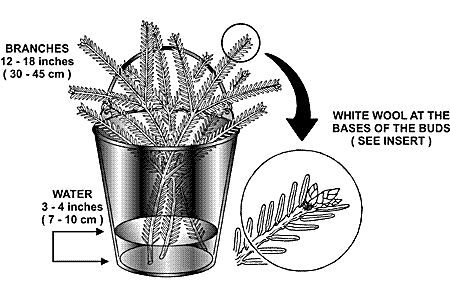
Balsam Woolly Adelgid Population Presence in True Fir Trees
Assessing the presence of a tiny insect before it becomes a problem can be a difficult task. Through their work with the balsam woolly adelgid, Keith Moore and Mike LeBlanc have developed a method to encourage the early activity of the adelgid. This is a good project to start in March to give you an idea of what you will be dealing with in the growing season. This procedure will not tell you how many insects you have but will indicate if they are present.
Procedure
- Randomly select three trees per location, and collect one branch per tree, about 12-18 inches long (30-45 cm) from the middle of the tree.
Choose branches that have slight gouting! - Stand the branches in a bucket containing 3-4 inches (7-10 cm) of water. See the drawing below for more detail on the set-up.
- Place bucket in a warm, heated area; preferably in front of a sunny window.
- Starting approximately five days later, begin to look for white, woolly masses at the bases of buds, under bark scales, or at the branch nodes. These woolly masses grow to about 1/16 in (2 mm) in size: a hand lens or magnifying glass will aid in this process.
This will give you a confirmation as to whether or not a population of agelgids exists on your trees. If you observe some woolly masses on the branches, watch for damage symptoms on all the trees in your lot. This will indicate to you that damage control may have to be implemented such as sanitation (tree removal), or if many trees are infected, a treatment may be considered.

This is the set-up for determining the presence of the balsam woolly adelgid. Note the enlargement of the white wool below the bud.
CAUTION: Read and follow the instructions on the label when using any control agent. Proper application and use of recommended personal protective equipment are essential for the safe use and effectiveness of any pesticide.
DISCLAIMER: Control options are suggestions only. Actions taken for pest control are the sole responsibility of the applicator in full compliance with any Federal, Provincial or Municipal Acts, Regulations or Bylaws.